‘Killers of the Flower Moon’ Used Grease and Hair Extensions to Show Mollie’s Health Decline
- Oops!Something went wrong.Please try again later.
- Oops!Something went wrong.Please try again later.
- Oops!Something went wrong.Please try again later.
- Oops!Something went wrong.Please try again later.
- Oops!Something went wrong.Please try again later.
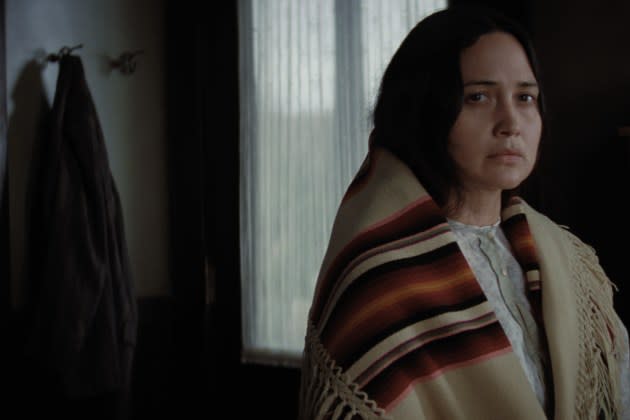
Based on the nonfiction book by David Grann, “Killers of the Flower Moon” stars Leonardo DiCaprio as Ernest Burkhart, a WWI vet who travels to Oklahoma to work for his wealthy uncle, William King Hale, played by Robert De Niro. It’s the early 1920s, and this part of Oklahoma sits on lots of oil, whose rights are owned by the Native American Osage and other tribes. They are prosperous, some even rich, and it’s here that Ernest meets Mollie (Lily Gladstone). They fall in love and marry, but the story’s undercurrent throbs with the mysterious death of so many Osage people and the white people assuming their oil rights.
Mollie’s sisters and mother die, and then Mollie herself gradually gets sicker. Is she being poisoned? Through a narrative rife with exploitation and death, the epic tale tracks the Reign of Terror, a string of murders within the Osage Nation that led to a federal investigation and the birth of the FBI.
More from Variety
The film’s team of artisans worked with Martin Scorsese to show how the illness was taking its toll, slowly killing Mollie. It all began with the director, who says his key to capturing Mollie came from spending time with Osage Nation members, including some related to the characters in the film. Scorsese gained insight through many conversations. “She was a resister, resisting the new ways that were destroying the culture,” he says. “She was very sharp and intelligent, but she was in love with Ernest, and he was in love with her. Now I have this love story, and yet [Ernest] is helping people kill her sisters. He may be poisoning her. We were fascinated by how they stayed together, and how they stayed together. Not necessarily why they stayed together.”
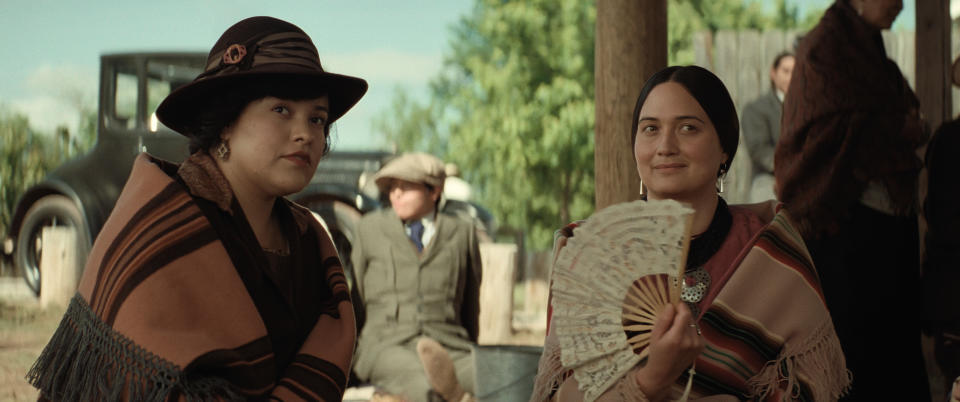
Hair department head Kay Georgiou began Gladstone’s transformation by adding volume to the actor’s hair. “Lily has great hair. We put in extensions to make it thicker, luscious, shinier and fuller. It’s easier to add and take away,” says Georgiou.
Gladstone was a key collaborator along with the artisans. One of the first conversations she had with Georgiou came from a previous relationship that impacted her health. Gladstone says, “There was a period in my life when maybe it wasn’t the healthiest relationship, but one of the ways my body reacted was that I lost a ton of hair, and the feeling of starting to fade away sets in.”
As the poison inexorably weakens Mollie, Georgiou explains, “We took the extensions out and put more grease into it to break it down more.”
Makeup department head Thomas Nellen created five stages for Mollie that began with her looking healthy. “I gradually lay [color] in her under eyes and made them deeper,” he says. “I added in circles, and we see her get paler.”
Gladstone also took three weeks off so she could prepare for those scenes, changing her physical appearance and losing weight. “She put herself on a regimen so she could look the part,” says Nellen. “We used an airbrush to apply makeup when she’s really sick and sweaty. That was Marty’s idea; he wanted her to look really bad and feverish.” When Mollie is finally taken to a hospital by the feds, she is at her weakest — eerily pale with hollow eyes. “That is all grease in her hair, and she just looks dreadful,” adds Georgiou.
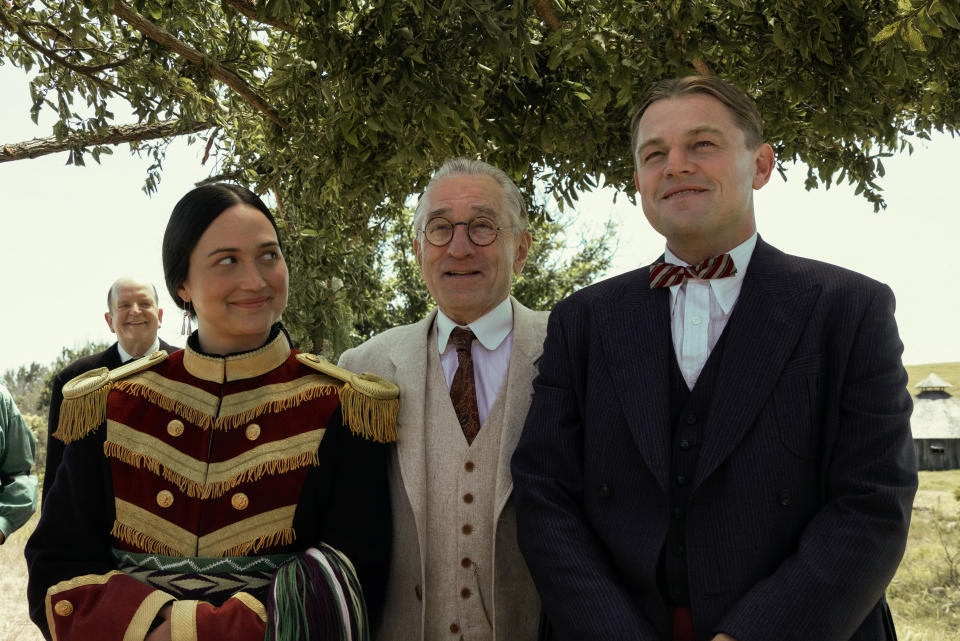
Costume designer Jacqueline West captured the tribal dress of the day in concert with Osage consultant Julie O’Keefe. Blankets proved an essential part of storytelling, with West procuring more than 1,000 of them from Pendleton and Osage artisans.
While Mollie was West’s prime focus, she and O’Keefe also looked at how the character’s sisters, Anna Brown (Cara Jade Myers), Reta (JaNae Collins) and Minnie Smith (Jillian Dion) would be portrayed. By contrast, says O’Keefe, “Mollie was the traditional sister, so Jacqueline put her in traditional clothing — sometimes colorful to counter the inner silence of the character.”
Gladstone says, “When I got tied into my first broadcloth skirt and gets cinched into that, suddenly you’re six inches taller, and you have to hold yourself like a ballerina.”
Through speaking with the Osage community, Gladstone and West made sure the blankets were held to demonstrate the patterning which showed what the status of a blanket was, thus honoring the women of the community.
West dressed Mollie in a U.S. military coat from the 1800s for her wedding scene. “It was adorned with all things authentically Osage: ribbon work, embroidery and a finger-weaving belt,” she says. “The top hat was important to American men’s dress and was reappropriated as part of the ceremonial nuptial dress for Osage women, who took feathers and made it their own to convey who they were. It’s almost a rebelliousness against the American military.”
O’Keefe notes that wedding coats were an important symbol of wealth showing that brides came from a family of prominent chiefs. As for using traditional colors, the only archival photos West had to go on were in black-and-white, so she had to get creative. “As things get darker for Mollie, so does her wardrobe,” West says. “I try to dress people from the inside out. I looked at what she would choose on a certain day, such as going to trial or when she makes a physical comeback. I tried to show that all in her palette was changing to reflect her mood.”
As Mollie’s health deteriorates, she becomes bedridden, and set decorator Adam Willis created a bedroom that felt very lived in. “We wanted it to feel like she spent a lot of time there,” he says. “It was dark but at the same time warm and inviting.”
Production designer Jack Fisk elaborates: “It was set-dressed so that the kids and everyone were sleeping upstairs. The dressing was minimal, which puts your focus on Mollie, and we didn’t show a lot of comfort in the tapestries or stuff that would be around her.”
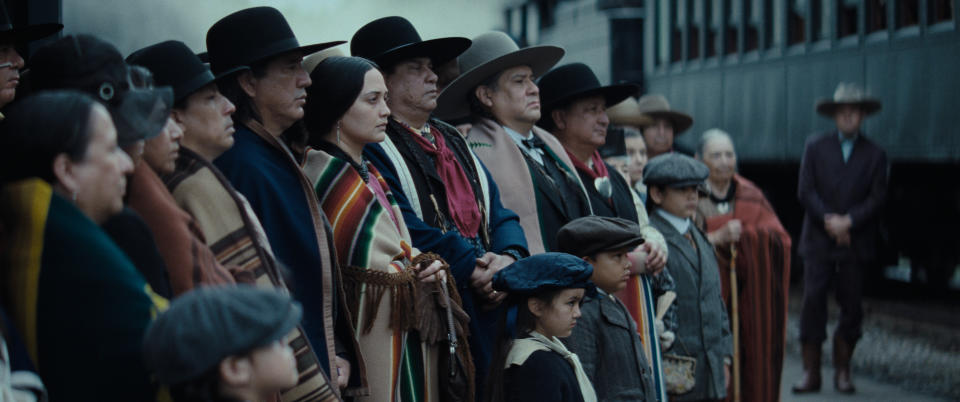
In framing Mollie, cinematographer Rodrigo Prieto was careful to keep things as objective as possible. But as the story unfolds, audiences get more and more drawn into Mollie’s perspective and mind. All through the shoot, he wanted to ensure a visual distinction between the European settlers and the Osage, and so his visual language was inspired by old-school photography and Technicolor techniques. The DP, who has worked on several Scorsese films, was inspired here by the Autochrome Lumière technique, a photographic process developed in 1903 by the Lumière brothers. “For everything that has to do with Ernest Burkhart and his uncle and the mastermind behind the exploitation of the Osage, William King Hale, I used a LUT [lookup table] that emulated the beginning of color and still photography.” But shooting each scene and player is a custom process. “When Ernest arrives, that is the way you see the environment, through those colors. It’s all relatively subdued,” Prieto says. But when Mollie is performing her longstanding dawn rituals, everything was “as naturalistic as possible.” Then as events escalate, so do the film’s visual motifs. “Once [Mollie’s] sister’s house explodes, the whole look of the movie changes, for everybody. It changes to a much higher-contrast, desaturated and grainy look.” With Mollie’s health rapidly declining, she goes to Washington, D.C., with the Osage delegation to call attention to the deaths and certainly illegal appropriation of Osage Nation land rights.
Prieto underscores that Mollie feels as if she wants to kill her family’s killers. “It’s a subjective point of view,” he says. “They’re looking at the camera. We’re directly in front and tracking with her — it’s almost a bit surreal. We had all this smoke blowing, and we get into her psyche.”
Once Ernest is taken away and Mollie receives medical attention, her journey to recovery begins. But not without one last confrontation and she asks him what he’s been giving her. She saw it as an opportunity to bookmark the Sho-Mee-Kah-See/ Coyote story. Gladstone says, ” Ultimately, the broad scope of the whole film feels and plays out like a trickster story. In the beginning, Mollie calls Ernest out but keeps it playful and light, but she’s got his number.”
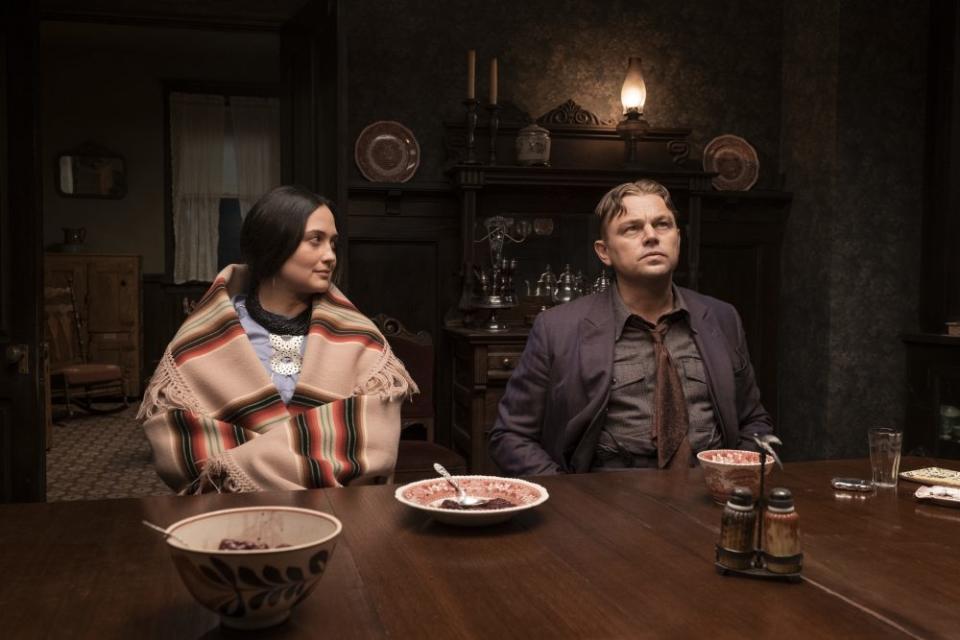
Best of Variety
Sign up for Variety’s Newsletter. For the latest news, follow us on Facebook, Twitter, and Instagram.

